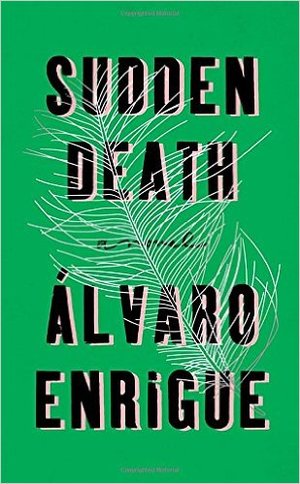‘Sudden Death’ by Alvaro Enrigue (2013) 261 pages Translated by Natasha Wimmer
‘Sudden Death’ is an incredibly rich entertaining whirlwind trip through the 16th century presented within the framework of a tennis match in 1599 between Italian artist Caravaggio and Spanish poet Francisco de Quevedo. Along the way, we have stops for English Queen Anne Boleyn and Spanish explorer Cortés and the church officials during the Counter Reformation as well as other excursions.
“I don’t know what this book is about. I know that as I wrote it I was angry because the bad guys always win. Maybe all books are written because in every game the bad guys have the advantage, and that is too much to bear.”
Instead of the usual axe, a sword was used by the special executioner from France brought in by English King Henry VIII in 1536 to behead Anne Boleyn. There is a rumor that this executioner kept some of her hair to make four tennis balls. Yes, this is spurious history, and I would not vouch for the accuracy of much that is in this novel. That does not make these apocryphal stories any less fascinating. The author Enrigue has these four Boleyn tennis balls bounce through the 16th century being passed from Pope to Cardinal to financier to favored artists. Thus we get to the time of the Counter Reformation and its accompanying tortures.
“Never were the connections among politics, money, art, and semen so tight or so murky or so unashamedly happy, tolerant, and fluid.”
There are also occasional side trips to Mexico where the Aztecs led by Montezuma make the fatal mistake of not executing Cortés and his men upon their arrival. For Enrigue who is from Mexico, the history of Cortés and Montezuma has special significance. “There are few better illustrations of how a whole host of people can manage to understand absolutely nothing, act in an impulsive and idiotic way, and still drastically change the course of history,” Enrigue says of Cortés and his men.
I did not even know that tennis went back that far, but apparently there was tennis already in the Middle Ages. Later Caravaggio was known for his realistic paintings and also for using prostitutes as models for his religious figures including the Virgin Mary. Caravaggio is considered the most important artist of the late sixteenth and early seventeenth century, yet he was jailed on several occasions and had a death sentence pronounced against him after he killed a young man in a brawl in 1604.
‘Sudden Death’ contains so much of history and of rumor that it can be quite an overwhelming experience to read this novel. However Enrigue presents all of this material in such a methodical and intriguing fashion it is ultimately pleasurable.
Grade: A

Posted by Alastair Savage on February 19, 2017 at 12:37 PM
Sounds great! There’s that quote from Christopher Marlowe too that talks about people being “the stars’ tennis balls” at about that time.
LikeLike
Posted by Anokatony on February 19, 2017 at 7:01 PM
Hi Alastair,
Your reference intrigued me so I looked up the exact quote:
“We are merely the stars’ tennis balls, struck and bandied which way please them.”
Christopher Marlowe, Doctor Faustus
That’s a great quote, makes me almost want to read Doctor Faustus.
LikeLike
Posted by Alastair Savage on February 19, 2017 at 7:37 PM
Oh please read it. It’s a wonderful play!
LikeLike
Posted by Anokatony on February 19, 2017 at 7:59 PM
Thanks for the lead.
LikeLike
Posted by Max Cairnduff on February 21, 2017 at 5:41 PM
I’ve seen a review of this previously and thought it sounds great, and here it is sounding great again. Genuinely clever and interesting.
And Dr Faustus is indeed a wonderful play.
LikeLike
Posted by Anokatony on February 21, 2017 at 6:21 PM
Hi Max,
I found ‘Sudden Death’ to be a wonderful read, not at all like our other Mexican writer Yuri Herrera, but wonderful just the same.
I intend to read Doctor Faustus very soon.
LikeLike